May 29, 2009
Air Date: May 29, 2009
FULL SHOW
SEGMENTS
Saving the Trees to Save the Planet
View the page for this story
International plans to preserve forests-- and the carbon dioxide sequestered in them-- have found a friend in the Waxman-Markey climate change bill. The House legislation would set up cap and trade revenues to help stop deforestation abroad. Host Steve Curwood talks with Alden Meyer from the Union of Concerned Scientists about what the legislation could mean for U.S. and global emissions. (06:35)
GMO-Trees
View the page for this story
Scientists are developing genetically modified trees for the forests of the future. Ann Peterman of the Global Justice Ecology Program tells host Bruce Gellerman that these designer trees don't measure up to what a real forest provides. (05:00)
Oil on Trial
View the page for this story
The world’s biggest oil companies are facing allegations of crimes ranging from failing to clean up spills all the way to murder. George Washington University’s International Law Professor Dinah Shelton walks host Steve Curwood through three landmark cases from Nigeria, Ecuador and Indonesia. (06:20)
How Green the New Supreme Court Nominee
/ Ingrid LobetView the page for this story
Living On Earth's Ingrid Lobet takes a look at some of Judge Sonia Sotomayor's environmental decisions, and some elements that may shape her outlook on upcoming environmental questions before the Supreme Court. (03:00)
Kids Speak Out
View the page for this story
From banning plastic bags to raising awareness about rising sea levels, kids are proving that they can be a powerful force in the battle against climate change. Author Lynne Cherry tells host Steve Curwood about several young leaders who are taking a stand to protect the planet. The kids are featured in her new documentary series, Young Voices on Climate Change. (05:45)
Land for the Good of All
/ Pamela FriersonView the page for this story
Living on Earth continues its series exploring features of the American landscape. It’s based on the book “Home Ground: Language for an American Landscape,” edited by Barry Lopez and Debra Gwartney. In this installment, Pamela Frierson explains the term “ahupua’a.” (02:10)
Note on Emerging Science
/ Liz GrossView the page for this story
The moon is thought of as a cold, barren place. But scientists are saying it doesn’t have to be that way. As Liz Gross reports, they hope to grow mustard plants in a shoebox-sized greenhouse on the surface of the moon by 2011. (01:55)
How to Build a Dinosaur
View the page for this story
T-Rex may be gone, but there are still dinosaurs all around us. Paleontologist Jack Horner tells host Bruce Gellerman that the birds we see every day are really avian dinosaurs. And he wants to give them the push they need to look like their extinct ancestors. Horner is the co-author of the new book, How to Build a Dinosaur. In it, he describes the science behind turning a chicken into chicken-o-saurus. (07:15)
The Hidden Sounds of Bird Song
View the page for this story
Birds hear four times better than humans. That’s according to renowned bird scientist Donald Kroodsma. But what do they hear? Kroodsma recorded some of the most famous songsters – the thrushes – and slowed down the recordings in his lab, revealing the many intricate details of bird song. Producer Laurie Sanders reports. (06:00)
This week's EarthEar selection
listen /
download
Sounds of a lone adult right whale near Peninsula Valdez in Argentina.
Show Credits and Funders
Show Transcript
Hosts: Steve Curwood, Bruce Gellerman
Guests: Lynn Cherry, Jack Horner, Alden Meyer, Ann Peterson, Dinah Shelton
Reporters: Ingrid Lobet, Laurie Sanders
Commentator: Pamela Frierson
Note: Liz Gross
[THEME]
CURWOOD: From Public Radio International - this is Living on Earth.
[THEME]
CURWOOD: I’m Steve Curwood.
GELLERMAN: And I’m Bruce Gellerman.
By paying to protect forests abroad, the United States could help meet its greenhouse gas goals at home.
CURWOOD: But not all forests or all trees are created equal.
PETERMAN: Forests in tropical regions store four times the carbon of a tree plantation. So, when you destroy a natural forest and replace it with a tree plantation you have just decimated the ability of that land to store carbon.
CURWOOD: Also – just how green is the new pick for the Supreme Court? A look at her record.
GELLERMAN: And birds hear much more in a birdsong than we do – and that has one ornithologist singing the blues -
KROODSMA: Oh, to be a hermit thrush for a day, to hear as they hear. It’s the only way we’ll really understand what they’re doing.
GELLERMAN: They whistle while we work.
CURWOOD: We’ll have those stories and more - this week on Living on Earth! So, stick around.
[NEWSBREAK MUSIC: Boards Of Canada “Zoetrope” from “In A Beautiful Place Out In The Country” (Warp Records 2000)]
ANNOUNCER: Support for Living on Earth comes from the National Science Foundation and Stonyfield Farm.
[THEME]
Saving the Trees to Save the Planet
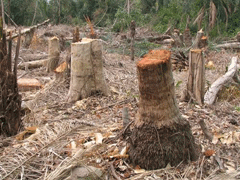
Deforestation in Bolivia. An estimated 20 percent of global greenhouse gas emissions come from deforestation.
GELLERMAN: From the Jennifer and Ted Stanley studios in Somerville, Massachusetts, this is Living on Earth. I’m Bruce Gellerman
CURWOOD: And I’m Steve Curwood.
The Waxman-Markey climate change bill now moving through Congress aims to reduce the level of green house gas emissions in the U.S. by 17 percent compared to 2005.
But there's another part of the bill that could cut emissions by another ten percent or more. It’s called "avoided deforestation", and it involves paying developing countries to keep their carbon-sequestering forests standing. Avoided deforestation is a key part of the UN climate negotiations that are resuming in early June in Germany. Joining us now is Alden Meyer, he’s director of strategy and policy for the Union of Concerned Scientists.
Welcome, Alden.
MEYER: Good to be with you, Steve.
CURWOOD: So, tell me, what could avoided deforestation in other countries do for U.S. plans to reduce greenhouse gas emissions? I mean, just how big a deal is this?
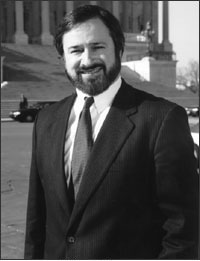
Alden Meyer of the Union of Concerned Scientists.
MEYER: Well, it’s a very big deal. Deforestation globally accounts for about twenty percent of worldwide CO2 emissions, carbon dioxide emissions. That’s roughly equivalent to the total emissions of the U.S. or the total emissions of China. And it’s more than the total emissions from all the vehicles, planes, buses, trains and ships in the world. So it’s a big deal. What is happening in the U.S. is the Waxman-Markey bill which is now moving thought the House includes a set aside of five percent of the allowances for emissions. We estimate that that would roughly be equivalent to three billion dollars a year in 2012 when the law takes effect, ramping up to about five billion dollars a year by 2020. And estimates are that for roughly twenty billion dollars a year you could probably cut that rate of deforestation in half. So the U.S. contribution of five billion dollars would go part of the way towards reducing deforestation over the next decade. In terms of emissions, the estimates are that this could result in emission reductions equivalent to about ten percent of U.S. current emissions.

Deforestation in Bolivia. An estimated 20 percent of global greenhouse gas emissions come from deforestation.
CURWOOD: So coming up in Bonn, Germany in June the world continues to talk about how to update the Kyoto Protocol. So how might the U.S. plans to pay for avoided deforestation in developing countries help our negotiating position there?
MEYER: Well, I mean, obviously one of the big issues of contention among many in this process is how ambitious the U.S. domestic target is. Most of the world would like to see us do substantially more than what the President committed to during the campaign or the target that’s in the Waxman-Markey bill, which would reduce emissions about seventeen percent below current levels or about four percent below what our emissions were in 1990, which is the benchmark used in both the Rio Treaty and the Kyoto Protocol.
CURWOOD: Parse that out of me a little bit more, Alden Meyer. How far away are we in terms of numbers from what other countries around the world would like to see?
MEYER: Well the bench mark that’s been talked about since the Bali negotiations two years ago is that industrialized countries as a whole – that’s Europe, Japan, the U.S. Russia, Australia, New Zealand, Canada, etc. – should be shooting to reduce their collective emissions by 25 to 40 percent below 1990 levels. The Waxman-Markey bill gets us domestically to about four percent below 1990 levels. If you add in this deforestation reduction funding that’s part of the bill, that gets you to roughly sixteen percent below 1990. That doesn’t get us fully into the range, but this is a significant achievement to have this provision in Waxman-Markey, which adds to the global lift towards meeting the reductions we need to avoid the worst impacts of global warming.
CURWOOD: Alden, to what extent can we buy our way out of making painful domestic emissions reductions?
MEYER: Well I don’t think this is seen as buying our way out, actually. The funding for reducing deforestation would not be an offset or a credit against our domestic reductions. It would not make them any easier. It would be on top of, which is one of the advantages of it in terms of the global negotiations. The other point to make here is, of course, we disagree with the whole premise that its painful and sacrifice and harmful to make reductions at home. In fact, our analysis released last month in testimony before the House Energy and Commerce Committee showed that you could get significantly deeper reductions in emissions domestically than the current Waxman-Markey bill calls for at net savings to American consumers of $900 per household through reduced energy bills. So this whole notion that it has to be painful to use energy more efficiently, to deploy cleaner resources like renewables – we disagree with.
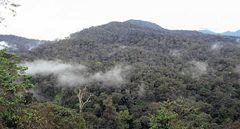
Forested hills in Kalimantan, Indonesia, where efforts are underway to sustainably manage the country’s carbon-rich forest and peatlands.
CURWOOD: This might be a good deal for the U.S., but what about the developing countries that we’ll be paying to do these reductions in terms of avoiding deforestation?
MEYER: Well it actually helps them as well because these funds will be used to provide alternative livelihoods and compensation to people that now make their living by cutting down the rainforests. In many cases, they would like to preserve the rainforest for future use and all the benefits they provide, particularly to indigenous people and others. But economics are forcing them to clear the land, burn down the rainforest, clear it for agriculture or for timber harvesting. This would provide an alternative income stream to recognize the value that these rainforests have in taking carbon up out of the atmosphere and storing it. It’s basically ecological services if you will, which right now they’re getting no compensation for. So if we can get the rest of the world, the other industrialized countries to join with the U.S., with countries like Norway that have already committed substantial money for this, this will actually be helping these countries get on a more sustainable development path.
CURWOOD: President Obama came into office pledging really to lead on climate change. How does this plan for the Democrats bolster or weaken that claim?
MEYER: Well I think it helps that claim, Steve, in the sense that it shows that he has at least part of Congress behind him going into this negotiating meeting in Bonn in June. He’s gotten across the first hurdle; Waxman and Markey have by getting this out of the Energy and Commerce Committee in the House. Obviously it still needs to go though the full House of Representatives and then probably the toughest hurdle of all, getting 60 votes on the Senate floor to be able to pass the Senate and go to the President’s desk. Of course when you get to the substance of the bill, I think the world would still like to see a higher level of ambition on the U.S. domestic target. And you’ll see the administration continue to be pressed for that by the Europeans, the Japanese, the Chinese and others, but it’s sort of a demonstration of good faith that the President at least has his own party and actually one Republican on the committee, Mary Bono from California, going along with this. So that’s, it’s a down payment. I think it gives them some credibility going into this next negotiation.
CURWOOD: Alden Meyer is Director of Strategy and Policy for the Union of Concerned Scientists. Alden, thanks so much for your time.
MEYER: Good to be with you, Steve.
Related links:
- Learn more about REDD from the Union of Concerned Scientists website.
- Learn more about a REDD framework in the United Nations
- For analysis and opinions on the potential pitfalls of REDD, click here.
- Click here for more on U.S. efforts to implement avoided deforestation.
GMO-Trees
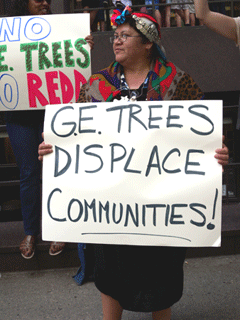
Maria Tesorera, from a women’s group in Chile, protests outside the Belgian Permanent Mission in New York City. Belgium recently planted a test plot of genetically engineered low-ligning poplar trees. (Orin Langelle)
GELLERMAN: While preserving forests holds great promise for reducing greenhouse gas emissions, not all forests are created equal. There are natural forests, which are home to a variety of trees, plant and animal life. Then there are tree plantations - where a single type of tree is grown for its commercial value.
Scientists are now experimenting with tree plantations, manipulating and modifying the genes of saplings that grow in these monoculture forests - and that’s a problem says Ann Peterman. She’s executive director of the Global Justice Ecology Project.
PETERMAN: One of the main trees that they’re genetically engineering is eucalyptus. But they’re also genetically engineering poplars and pines, so those three species are pretty much the three main forestry trees that they’re genetically engineering. And they’re mainly doing it either for pulp and paper, for cellulosic fuel – in other words biofuels made out of trees – or for timber, in the case of some of the pine. So they’re genetically modifying them to enhance some of the traits. In the case of timber, they want, you know, straighter trees or less branches or, you know, if they could grow two by fours that would make them very happy. Or in the case of paper, they want to actually create trees that have less lignin. Lignin is the structure in a tree that makes it strong, that protects it against insects, disease, fungus, etc, but makes it very hard to make paper or fuel. So if they have low lignin trees, they can more easily process them, they say, into paper or fuel.
.gif)
Ann Peterman reading about the ecological dangers of genetically engineered trees at the UN Convention on Biological Diversity. (Orin Langelle)
GELLERMAN: When you say “they” you’re talking about companies.
PETERMAN: Right, I’m talking about the paper industry, the biolfuels industry, etc.
GELLERMAN: What’s the problem. I mean, they’re saying we need to be more sustainable, we need to grow sustainable products, provide for an ever-expanding population and this is good.
PETERMAN: Their argument is that this will grow more wood on less land. Less forest will be cut down because we can concentrate the amount of timber that we’re growing on a piece of land. But as we’ve seen with traditional plantations that are already developed all over the world, they do not protect forests, they destroy forests. And the reason is because plantations are worth more money than natural forests. They can get more timber out of them or they can get a specific kind of timber out of them. In a natural forest they can’t do that. So, it’s worth more money.
GELLERMAN: So what you’re saying is, it’s a driver of deforestation. They would go in and they would deforest a natural rainforest or tropical forest. And then plant these plantation forests.
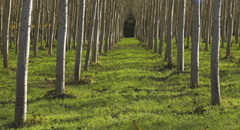
Tree plantations are planted in straight rows with a single species of tree. (Photo: Andy Coulson)
PETERMAN: Exactly, and you see that in Brazil. They’ve pretty much decimated the Mata Atlantica forest ecosystem in Brazil to replace them with eucalyptus plantations. Now they’re talking about going into the Amazon and replacing parts of the Amazon with eucalyptus plantations. So, yes, tree plantations have been a huge driver or deforestation all over the world.
GELLERMAN: But a tree is a tree is a tree. I mean, if you cut down a tree and you’re planting genetically modified eucalyptus in terms of carbon, is there a difference?
PETERMAN: There is actually, there’s a huge difference. And it’s not just, of course, the carbon storage, but the biodiversity, you know, the ability of the forest to sustain populations, human populations in a way that plantations can’t. But getting back to the carbon issue, forests in tropical regions store four times the carbon of a tree plantation. So when you destroy a natural forest and replace it with a tree plantation, you have just decimated the ability of that land to store carbon. Clearly, that’s gonna have impacts on the climate, not to mention the actual act of deforestation itself has huge carbon emissions. Studies have shown at the very least twenty percent of annual carbon emissions come from deforestation and more recent studies are saying it’s probably considerably more than that.

Maria Tesorera, from a women’s group in Chile, protests outside the Belgian Permanent Mission in New York City. Belgium recently planted a test plot of genetically engineered low-ligning poplar trees. (Orin Langelle)
GELLERMAN: In Brazil they are planting to count plantation trees as forest.
PETERMAN: Yeah, they do in many parts of the world. The UN allows plantations to be considered as forest. It’s just an incredible bad definition of forest that the UN uses that allows this to happen and that desperately needs to be changed. In Brazil they call tree plantations green deserts because they’re so destructive and because they are basically devoid of any other species except the monoculture of that tree.
GELLERMAN: And where on the planet is the number one place where they’re planting genetically engineered trees?
PETERMAN: China, at this point. China’s the only place in the world where they have commercially released genetically engineered trees at this point. The U.S. is in the process of trying to figure out if they want them to be legal here, Brazil is in a similar process, they’re moving forward with it. But China is the only place where they actually have commercial plantations.
GELLERMAN: Ann Peterman coordinates work on genetic trees for the Global Forest Coalition and directs the Global Justice Ecology Project.
Related link:
Global Justice Ecology Project
[MUSIC: Brian Blade “All That Was Yesterday” from Mama Rosa (Verve 2009)]
CURWOOD: Coming up – big oil companies face environmental justice lawsuits around the world. Keep listening to Living on Earth.
[CUTAWAY MUSIC: Ernest Ranglin “Memories Of Barber Mack” from Memories Of Barber Mack (Island Jamaica Jazz 1997)]
Oil on Trial
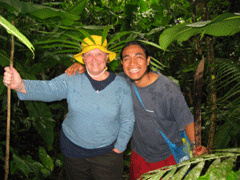
Dinah Sheldon tours the Ecuadorian jungles with a local guide.
GELLERMAN: It’s Living on Earth, I’m Bruce Gellerman.
CURWOOD: And I’m Steve Curwood.
Three of the world’s biggest oil companies are currently battling environmental human rights lawsuits. The Exxon Mobil case involves Indonesia. The Chevron/Texaco suit is in Ecuador. And the Shell case involves Nigeria. That case is about to go on trial in a New York federal court.
The relatives of author Ken Saro-Wiwa and other activists allege Shell conspired with the Nigerian government to falsely accuse and execute Saro-Wiwa and eight of his colleagues.
Dinah Shelton is a Professor of International Law at the George Washington University and joins us now. Welcome.
SHELTON: Thank you very much. Pleasure to be here.
CURWOOD: Professor Shelton, what’s Shell’s defense to charges of collusion with the Nigerian government?
SHELTON: Well, Shell is saying that they had no deal, that they were simply conducting their own activities, they were not responsible for what the government did and that they had asked the government to grant clemency to Saro-Wiwa. And the family says that they can prove that Shell’s Nigerian subsidiary director met with Saro-Wiwa’s brother and offered freedom in return to an end to the opposition to Shell’s activities. So all of this is evidence that will have to be litigated in the trial.
CURWOOD: Why are they trying this case in New York?
SHELTON: Well they’re trying it in New York because, of course, Shell is in New York, and the very first United States Congress in 1789 passed a statute allowing aliens to come to the United States and sue defendants found here for violations of treaties to which the U.S. is a party or violations of international law more generally.

Dinah Shelton tours the Ecuadorian jungles with a local guide.
CURWOOD: Now there are other substantial oil lawsuits that are going on right now. Both Ecuador and Indonesia have some large cases in the works. Chevron is being sued for 27 billion dollars for polluting the jungle. I gather that case has actually left the United States and is in Ecuador now.
SHELTON: So, the case spent about fourteen years in U.S. courts with first Texaco and later Chevron arguing that it should be in the Ecuadorian courts and now they’re trying to argue their way out of the Ecuadorian courts so. There doesn’t seem to be a forum they really like.
CURWOOD: Why do they say that they shouldn’t be in court in Ecuador if that’s what they argued before?
SHELTON: Well, the government has changed. Originally when the case was filed in New York, the President of Ecuador came in and sought to have the case dismissed saying that this would be very harmful to Ecuadorian interests. The government has since changed. The government now is more concerned with environmental protection. One of the reasons why these cases often end up in U.S. courts is that the domestic courts in the foreign countries are not always strong institutions and the judges may follow the prevailing political opinion within the country.
CURWOOD: You’ve spent some time in Ecuador and seen some of the polluted areas. How bad is it?
SHELTON: Well the pollution isn’t always visible because it’s primarily in the water system. But you do see as you go along areas where the oil company activities have occurred that there is a sheen on the water, the water looks like oil. It doesn’t look like pure water. And this is an area, a rain forest, where there are inundations on a daily basis and yet, it is not enough to sweep away the oil.
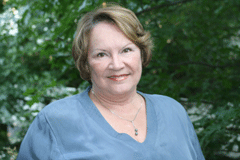
Dinah Shelton is a professor of International Law at George Washington University Law School.
CURWOOD: Now in Indonesia Exxon Mobile is being sued by some villagers in Ache for human rights violations allegedly committed by soldiers guarding a natural gas plant. What exactly are the allegations in that case?
SHELTON: They’re very similar in many ways to the Ken Saro-Wiwa case. That, in this instance, the company was directly hiring the military to protect their interests there with the result that there were what in other countries might be called ethnic cleansing, that there have been killings, there have been burnings of villages. It’s very similar to the Nigerian case in respect of the type of violence and abuses that are alleged.
CURWOOD: What does it mean that all this is happening now? What kind of signal is it that we may be at some new level of accountability for international companies?
SHELTON: Well, I think that it really is a break from traditional human rights law, which focused on strong, repressive governments. The whole paradigm of human rights violations was Hitler, and human rights law was designed to prevents types of massive human rights violations from occurring again through strong governments. In all three of the cases that you mentioned and many of the other corporate responsibility cases, there are very good laws in place in the states where these companies are acting, but those laws are not enforced, the institutions are weak, the policing is weak, there may be rampant corruption as there was in Nigeria under the Abacha government. And the consequence is that individuals are finding themselves victims of violations by a conspiracy, if you will, or a joint venture between governments and powerful multinational companies.
CURWOOD: You recently testified in front of Congress about these cases, and I know at one point you were asked why we should care, why the United States and the Congress should care about the abuses that are alleged in these cases. What was your answer?
SHELTON: Well my answer is that when companies are linked to abusive regimes, they’re engaged in murder, they’re engaged in destructions of property and whole entire cultures, it reflects back on the United States. So that’s one reason. A second reason is because people who’s rights are violated, who are no longer able to live in their own environment because it has been destroyed are going to move elsewhere. And we are going to see more and more environmental refugees as well as human rights refugees if this conduct continues. Thirdly, in the long run, the corporations are going to find themselves in enormous difficulty because the people turn to violence, and the corporations have seen hostages being taken, they’ve seen violence directed against them. So it’s in their interest as well. Not to mention the fact that – it’s the law.
CURWOOD: Diana Shelton is a professor or International Law at the George Washington University Law School. Thank you so much.
SHELTON: You’re welcome. Thank you for inviting me.
Related link:
Click here for the transcript of the Congressional hearing on human rights.
[MUSIC: Dean Fraser “It’s Me Again Jah” from Big Up (Island Jamaica Jazz 1996)]
How Green the New Supreme Court Nominee
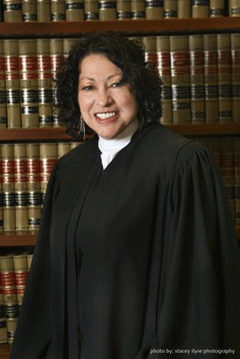
Judge Sonia Sotomayor. (Courtesy of the White House)
GELLERMAN: In choosing Judge Sonia Sotomayor for the nation's highest court, President Obama has selected a legal scholar with roots in Puerto Rican culture. Judge Sotomayor grew up in the New York City barrio of the Bronx and of course is a lifelong Yankees fan. She excelled at Princeton and Yale and has been a U.S District Court judge for 17 years. In that time she’s ruled on a number of environmental cases…and Living on Earth’s Ingrid Lobet looks at her decisions.

Judge Sotomayor’s ruling on power plants and aquatic life was a win for environmentalists. (Photo: Wigwam Jones)
LOBET: The best-known environmental decision by Judge Sotomayor is a case about power plants that are located along rivers and the damage they cause to aquatic life through their giant water intakes. In 2007, riverkeepers around the country challenged an Environmental Protection Agency rule on how power plants upgrade their intakes to protect fish. EPA had allowed plant operators to use cost-benefit analyses in making the equipment selection. In other words they could choose the less expensive of two technologies, even if that meant fewer fish would be saved.
Judge Sotomayor's opinion is seen as siding with environmentalists. She wrote that since the Clean Water Act requires the "best available technology" -- that doesn't leave room for a cost-benefit analysis.
Some legal scholars say she was reading the clear language of the law. But just a few weeks ago her decision was overturned by the Supreme Court, in an opinion by Justice Scalia who found nothing in the law that prohibits balancing benefit against cost.

Judge Sonia Sotomayor. (Courtesy of the White House)
Another opinion authored by Judge Sotomayor took a relatively unsympathetic view of a woman whose husband had worked aboard oil tanker ships, and died at the age of 39 from squamous cell skin cancer. The woman alleged his cancer was caused by exposure to benzene and hydrocarbons aboard ship. Sotomayor upheld the lower court that dismissed the suit.
Judge Sotomayor took part in a decision in 2005 that appears sympathetic to owners who lose their property through eminent domain for urban renewal. The panel of three judges said the Village of Port Chester, New York needed to do more to inform a property owner about public meetings and the appeals process for the taking of his property.
There are a number of influences that may have helped shape Judge Sotomayor.
Except for the periods she spent on the leafy campuses of Princeton and Yale, she's lived in urban New York, first in the Bronx, now in lower Manhattan.
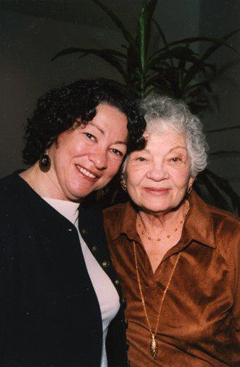
Judge Sotomayor with her mother, Celina Sotomayor. (Courtesy of the White House)
Her mother worked as a nurse in a methadone clinic, which could give Judge Sotomayor a deep understanding of drug addiction. Heroin has been particularly devastating in the Puerto Rican community.
And as a lawyer in the Manhattan district attorney's office she prosecuted assault, robbery and police brutality cases. Then she went on to practice intellectual property law.
There's much attention to Sonia Sotomayor as a woman and a proud Nuyorican. But if she's confirmed her education and work experience are likely to be factors at least as strong in deciding environmental questions that might reach the supreme court in the coming years, such as whether a dry riverbed constitutes a river…or how to limit industrial emissions in the hope of preserving polar icecaps.
For Living On Earth, I'm Ingrid Lobet.
[MUSIC: Eye Contact “Nuyorican Nights” from Havana Manana (Bembe Records 1999)]
Kids Speak Out
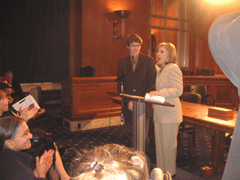
Senator Barbara Boxer introduced Alec Loorz at this town hall meeting in the Dirksen Senate Office Building in April 2009.
CURWOOD: There are plenty of proposed laws and ongoing international negotiations trying to address rapid climate change, but for some kids the adults are moving way too slowly:
[MUSIC AND YOUTH AT RALLY CHANTING, “WHAT DO WE WANT? STOP GLOBAL WARMING! WHEN DO WE WANT IT? NOW! SAYS WHO? I DO!”]
CURWOOD: One chronicler of the youth movement to fight climate disruption is Lynne Cherry, author of “How We Know What We Know About Climate Change.” She’s been interviewing young activists and recording them on video to give their voices a broader reach.
CHERRY: When kids speak out, it really gets to your heart. I’ve been showing these. They’re just three and a half minute shorts that we have right now, and people – they get tears in their eyes, they really get choked up, because they care about their kids and the kids are basically fighting for their future.
LOORZ: My name is Alec Loorz I’m thirteen years old. I’m in eighth grade, and I go to Ventura Charter School. I never knew about climate change at all until I saw Al Gore’s movie “An Inconvenient Truth.” Kids are the ones who will be most affected by global warming. By the time we’re middle aged, climate change will be a huge crisis if nothing is done today to help us.

Senator Barbara Boxer introduced Alec Loorz at this town hall meeting in the Dirksen Senate Office Building in April 2009.
CURWOOD: So tell me about Alec Loorz – what is he doing to make a difference about climate change?
CHERRY: Alec’s come up with several projects. One is his SLAP Project, Sea Level Awareness Project, and he’s been with his group, they’ve been putting sea level awareness posts all around Ventura, coast of Ventura, to show with each degree of warming where the sea level will be. Alec also has a Declaration of Independence from fossil fuel.
LOORZ: When in the course of human events it becomes necessary for one people to rid themselves of an energy system that has been found to threaten their lives and liberties, it is only decent that they should declare the causes of separation from the usage of fossil fuels.
CHERRY: It’s gonna be on the website of the Alliance for Climate Education and it’s a sign on campaign. So kids all around the world will be able to sign this Declaration of Independence.
CURWOOD: Now there are a number of cities and towns around the country who have tried to ban plastic bags and in Santa Monica there’s a group of kids called Teen Marine who took up the issues themselves and well here’s a clip from one of them.
BOY: I, myself, as a teenager using reusable bags at the grocery store. I get looked at a lot because I’m a teenager, you know what I mean? Teenagers don’t really use reusable bags, you know. It’s not cool. But I mean I think it’s cool and definitely everyone can do it.
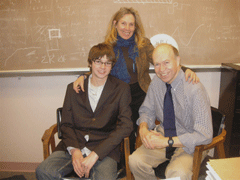
Alec Loorz, Lynne Cherry, and NASA climate scientist Dr. James Hansen.
CURWOOD: So what other ideas have they come up with along with reusable bags to combat the use of plastic bags and how did they persuade the city to impose a ban?
CHERRY: Well Evelina in that same film says that fourteen plastic bags is the equivalent of driving one mile. And also they did research, they actually counted the number of plastic bags that they found on the beach, in trees, along roadsides. It was like collecting scientific data about the effects of trash on the ecosystem. And so they took this data, this study they did and they presented that.
CURWOOD: At some point in this I’m guessing you asked the kids why it is that it’s so hard for adults to get this.
CHERRY: The kids think that the adults just don’t want to change their ways, but they also realize that a lot of adults are limited by the amount of time they have in their day. And so the kids are taking it upon themselves. On of these kids, Shannon McComb, she’s says, “If you adults won’t do something about climate change, then we kids are going to take the reigns.” That really is the sentiment of most of these kids. Some of these kids say you adults don’t have that much time left on this planet, you know, we’re very old to them. They think that their whole future is ahead of them, and they really care very much about saving the earth for themselves and for their children.
CURWOOD: I don’t want to sound cynical, but, you know, typically teenagers don’t much care about the future. I mean if you tell them that their book report is due next week, they’ll say “oh yeah” and they’ll get on the skateboard or head off to the beach. Typically they’re in the now.
CHERRY: Well I think the reason that kids aren’t really doing anything is because they think they can’t. The messages that they get from the media is that there’s nothing you can do about this, this problem’s too big for anyone to solve. But once these kids start doing something, they find that action is the antidote to fear and demoralization. And they find that they’re succeeding beyond their wildest dreams. There’s one girl in the movie, Erica Fernandez, who was actually successful in organizing a thousand people in her community and stopping a liquefied natural gas plant from being built off the coast of Oxnard, California.
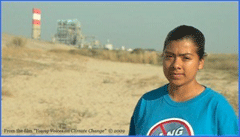
Erica Fernandez, from Mexico, had not been in the U.S. long when she helped organize her community against an LNG plant off the beach.
FERNANDEZ: Being involved in stopping this company, it gave to youth a lot of confidence. And I personally can say that it gave me the power to believe that I could make a difference.
CURWOOD: So there’s more to life than the video game.
CHERRY: Yeah, I think that these kinds of projects really do give the kids’ lives meaning. It’s really exciting for them to find that their voices are important. Like in the movie Alec says, “Kids have power. Kids can make a difference.”
CURWOOD: Lynne Cherry is an author, illustrator and environmental activist. Her movie shorts are playing right now at the American Museum of Natural History in New York City. And for a link to her new website, you can go to ours at loe.org. Lynne, thanks so much.
CHERRY: Thank you, Steve.
Related links:
- Check out Lynne Cherry’s website
- For more about citizen science and Lynne Cherry’s children’s book on global warming, click here.
- Young Voices on Climate Change.
[MUSIC: Daniel Lanois “O Marie” from Acadie (Red Floor Records 2008 Reissue)]
Land for the Good of All
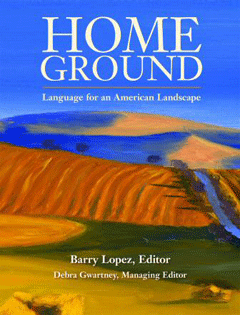
"Home Ground: Language for an American Landscape," edited by Barry Lopez and Debra Gwartney. (Courtesy of Trinity University Press)
GELLERMAN: One danger of climate change is that it may destroy the most cherished features of our home planet: our forests, seashores, glaciers and snow-capped mountains.
Describing the features of the landscape enriches our appreciation and understanding. Learning about the geography that surrounds us, connects us, it puts us into context, which is the goal of the book “Home Ground,” compiled by Barry Lopez and Debra Gwartney.
From time to time we take note of this miscellany of American landscape descriptions. Today Pamela Frierson has an historical term from Hawaii: ahupua‘a.
FRIERSON: Ahupua’a. The most important unit in the ancient Hawaiian system of land division was the ahupua'a, a pie-shaped wedge running from a high point on the island to the coast and some distance out to sea. Since Hawaiian Islands tend to have rain-carved valleys originating at central mountains and opening out toward the coast, an ahupua'a often roughly followed the contours of watersheds.

"Home Ground: Language for an American Landscape," edited by Barry Lopez and Debra Gwartney. (Courtesy of Trinity University Press)
The coastal boundaries were marked by an ahu, a heap of piled stones supporting a carved wooden image of a pua'a, or pig--symbol of the tribute paid annually to the paramount chief of the island by the lesser chiefs in charge of each ahupua'a. The commoners within an ahupua'a, living in extended families, held tenancy to small landholdings called 'ili. The ahupua'a provided the resources to sustain a community: access to upland forests for timber, lowlands for growing crops, and fishing and gathering along a stretch of coast. This traditional system ended in 1848 when Kamehameha III was persuaded by foreigners to institute the Great Mahele, or division, which allowed land to be bought and sold. In modern times ahupua'a holds both the traditional meaning and a broader one of environmentally responsible land use.
GELLERMAN: Writer and photographer Pamela Frierson lives on the slopes of Mauna Kea Volcano on Hawaii Island. Her definition of “ahupua‘a” comes from the book “Home Ground: Language for an American Landscape”, edited by Barry Lopez and Debra Gwartney.
Related link:
Check out the Home Ground project.
[MUSIC: Ledward Kaapana “Kaulana Na Pua” from Grandmaster Slack Key Guitar (Rhythm And Roots Music 2006)]
CURWOOD: Just ahead: why people miss out on music that’s strictly for the birds. Stay with us on Living on Earth.
ANNOUNCER: Support for the Environmental Health Desk at Living on Earth comes from the Cedar Tree Foundation. Support also comes from the Richard and Rhoda Goldman fund for coverage of population and the environment. And from Gilman Ordway for coverage of conservation and environmental change. This is Living on Earth on PRI, Public Radio International.
[CUTAWAY MUSIC: Brad Shepik: “Not Sor Far” from Human Activity Suite (Songlines Records 2009)]
Note on Emerging Science
GELLERMAN: It’s Living on Earth. I’m Bruce Gellerman.
CURWOOD: And I’m Steve Curwood.
Coming up: do it yourself – how to build a dinosaur. But first this note on emerging science from Liz Gross.
[COUNTDOWN FROM LUNAR MISSION]
GROSS: Between 1969 and 1972, NASA sent astronauts to the moon six times.
[SOUND OF LIFTOFF]
GROSS: Since then, earthlings haven’t set foot on its surface. But in 2011, a lunar lander plans to apologize for our long absence – by bringing flowers.
[THEME]
GROSS: Engineers at Paragon Space Development announced their plans to send a small greenhouse to the moon. At one foot tall and just inches in diameter, the structure has enough room for six mustard seed plants.
Paragon hopes to show that a plant can successfully complete its life cycle on the moon. This won’t be an easy task. Lunar nights can plummet to 240 degrees below zero Fahrenheit. Researchers worry the flowers won’t be able to survive the extreme cold.
Fortunately, mustard plants grow fast. The whole process, from seed to flower takes just two weeks, which happens to be the length of a lunar day. This means the project can be completed before day turns to frigid night.
Cold nights are not the only obstacle to this moon garden. The engineers are also concerned with controlling for radiation, ensuring the plants get water, and designing a greenhouse strong enough to withstand the trip through space.
They see the experiment as a crucial step towards human existence on the moon’s surface, albeit in a biodome. If nothing else, the image of a fragile lunar flower, with earth rising in the background, could prompt our curiosity about the moon to blossom once again.
That’s this week’s note on emerging science. I’m Liz Gross.
Related link:
For more on the mustard-moon project, click here
CURWOOD: You can hear our program any time on our website, or get a download for your mp3 player. The address is loe.org – that’s loe.org. There you’ll also find pictures and more information about our stories. And we’d like to hear from you. You can reach us at comments@loe.org. Once again, comments@loe.org. Our postal address is 20 Holland St. Somerville, MA 02144. And you can call our listener line any time at 800-218-9988. That’s 800-218-9988.
How to Build a Dinosaur
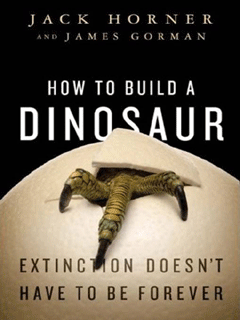
GELLERMAN: If things had been just a little bit different, we wouldn’t ask - why did the chicken cross the road, but why the dinosaur did it.
In terms of evolutionary development, dinosaurs are close kin to today’s modern birds. In fact, paleontologist Jack Horner says chicken eggs just need a little nudge to bring out the dino DNA. And that’s precisely what he proposes doing in his new book, “How to Build a Dinosaur.”
Jack Horner is curator of paleontology at the Museum of the Rockies in Montana and he’s the recipient of a MacArthur genius award. Jack Horner joins us from Bozeman. Welcome to Living on Earth!
HORNER: Thank you. It’s nice to be here.
GELLERMAN: How to build a dinosaur. Do you think we can go through this interview without talking about Jurassic Park?
HORNER: [Laughing] Well I hope so. [Laughing] Michael Crichton had a cool idea. You know, I mean it was – it’s an interesting notion that you could find an insect that had bitten a dinosaur and sucked its blood out and then just get the blood out of the insect and get the DNA out. And, you know, it’s an interesting idea. And we’ve been looking for dinosaur DNA in extinct dinosaurs for quite a while now, and unfortunately we think that the chances of finding ancient DNA is pretty low.
GELLERMAN: You say that I can build a dinosaur – or that you can build a one.
HORNER: [Laughing] Well … science can build one. First off, it’s been established and has been known for quite some time that all birds are a group of theropod dinosaurs. So technically a bird already is a dinosaur and you don’t really have to do anything to make a dinosaur out of a bird, ‘cause they are one. But aesthetically they really don’t look like one because birds don’t have long tails and, of course, they don’t have teeth, and they have wings instead of hands.
GELLERMAN: There was an interesting discovery, a recent discovery in Canada - they found the smallest dinosaur in North America. It was a meat-eating creature about the size of a modern chicken. It ran on two legs and it was covered in feathers. Did dinosaurs have feathers?

HORNER: First off, all dinosaurs were warm blooded. We have very good evidence that all dinosaurs were warm blooded, and therefore, either young dinosaurs or small dinosaurs would have required some kind of insulation to keep their warmth in their body. And so feathers are their invention. And a lot of the feathers were probably display feathers as well.
GELLERMAN: We wouldn’t find feathers on t-rex, would we?
HORNER: I think we would when t-rex was small.
GELLERMAN: Oh.
HORNER: When they hatched out of their eggs, yeah.
GELLERMAN: Oh. They’re like little fluffy little dinosaurs.
HORNER: Yeah, little down covered, yeah. I think so. You know, if you look at birds - avian dinosaurs - basically every characteristic that we think of as being a bird characteristic was first invented by the extinct dinosaurs. Feathers is one of those characteristics. The wishbone is another. Hollow bones - that’s another. And, you know, the list goes on and on and on and that’s one of the reasons we know that birds, avian dinosaurs, are the descendents of extinct dinosaurs, the non-avian dinosaurs.
GELLERMAN: So t-rex was closer to an ostrich than an alligator?
HORNER: Yes, absolutely. Crocodiles and alligators are ancient relatives of dinosaurs, but they’re not dinosaurs. So, they only living animals we have that are living dinosaurs are birds.
GELLERMAN: So the idea is to take a chicken embryo, an egg, and turn it into chicken-osaurus.
HORNER: Right. Chicken-osaurus. So the first steps into this whole business is just figuring out which genes need to be flipped on or flipped off and how to do it.
GELLERMAN: So you’re not talking about changing the DNA.
HORNER: No.
GELLERMAN: You’re basically gonna kind of interrupt things in the egg phase. You call it evo-devo or devo-evo.
HORNER: Right. Well, that’s what everybody calls it. Evolutionary development is a cool thing and its kind of a new science having to do with looking at the development of an animal and sort of relating that to its evolution. As we all know, even the embryo of a human being looks very different that a human being when it’s developing. A human being, for example, at some point in the development of the embryo has a tail. And then a gene kicks on an actually disintegrates that tail.
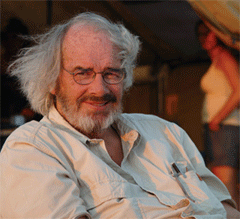
Paleontologist Jack Horner.
GELLERMAN: So changes in the embryonic development can make dramatic changes in the evolution of an animal.
HORNER: Absolutely. That’s the cool thing about evolution. And the same thing happens with a bird. A bird begins to form a long tail, which its ancestors had, but then a gene kicks on and disintegrates that long tail. A bird also develops a hand. It starts out with a five-fingered hand and then a gene kicks on or maybe a complex of genes kicks on and destroys two of those fingers leaving it with a three-fingered hand, which is what a typical theropod dinosaur has. And then another gene kicks on and actually fuses those three fingers together to form the end of the wing. And so, you know, the book really is about going in and flipping the switches so that the tail doesn’t disintegrate and the three-fingered hand doesn’t fuse together to make a wing, but hatches out with a long tail and a three-fingered hand.
GELLERMAN: You know, it seems that as a paleontologist you have the answer to the question, what came first: the dinosaur or the egg.
HORNER: [laughing] That’s right.
GELLERMAN: In your case its gonna be the egg.
HORNER: That’s right.
GELLERMAN: Well how close are we to doing this, to building a dinosaur?
HORNER: Well again it depends on your definition of the dinosaur. Chickens already are dinosaurs. Therefore, we have them already. If you’re talking about, you know, how close are we to having a chicken with a long tail, I’d say very close. A chicken with hands instead of wings? Very close. But, you know, an animal that looks like a t-rex? That’s a long ways off.
GELLERMAN: So this is really possible?
HORNER: It certainly is, yes. If we can figure out how we went from dinosaurs to birds, there’s no reason, you know, no reason not to go the other way. But, you know, the idea is not just to build a dinosaur. The whole idea behind this really is to figure out how to turn genes on an off, to find the right genes to turn on and off, and in the end, you know chicken-osaurus is a cool idea and it would be fun, but once we understand how and which genes to turn on and off, you know, hopefully we can solve some of our genetic diseases.
GELLERMAN: So if we did build a dinosaur, it would taste like…?
HORNER: Chicken.
[LAUGHING]
GELLERMAN: Paleontologist Jack Horner’s new book is “How to Build a Dinosaur”
Related links:
- Penguin Group's page for How to Build a Dinosaur:
- Jack Horner's page at Museum of the Rockies
The Hidden Sounds of Bird Song

Wood Thrush (Courtesy of USFWS)
CURWOOD: And here’s a taste of dinosaur music.
[SOUND OF A HERMIT THRUSH]
CURWOOD: The sweet melodies of dino-descended songbirds tell us of the passage of time: the break of day, the start of spring, the end of summer.
Those same songs tell other birds who’s around, keep out of my territory, I’m looking for a mate. And bird scientists believe our ears miss much of what the songbirds themselves can hear. Producer Laurie Sanders visited a birdsong expert in Amherst, Massachusetts, to take a closer listen to some of our most talented songsters – the thrushes.
SANDERS: The song of the wood thrush is sung in the dim light of the early morning and in twilight’s quiet hours. Its sweet beauty evokes feelings about the purity and peacefulness of wild, untrammeled nature. And those sentiments come to us, even though we’re missing most of the song’s details. Birds can hear at least four times in time better than we can. Don Kroodsma is a world authority on birdsong.
KROODSMA: In some of these birds, like the wood thrush, when we listen with our unaided ear, we’re hearing a little bit of magic, enough that people proclaim this is one of the finest songsters in the world. But when you slow it down and listen to it the way I think a wood thrush itself hears it, it is absolutely mind-boggling.
SANDERS: Kroodsma says although slowing down a recording changes the pitch and timing, now we can hear the intricate details that our ears would otherwise miss.
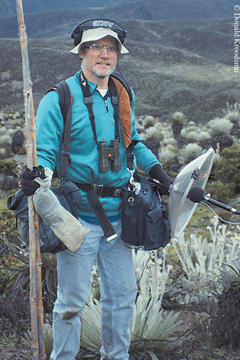
Donald Kroodsma in the field with recording equipment (Donald Kroodsma ©)
[SOUND OF THRUSH CALL]
KROODSMA: Now we go to half speed.
[SOUND OF THRUSH CALL]
KROODSMA: Now quarter. This is where I like to listen to the first part especially.
[SOUND OF THRUSH CALL]
KROODSMA: And now all the way down to 1/8 speed.
SANDERS: To produce these extraordinary songs, songbirds have not one voice box like us, but two. The left voice box produces the lower notes, while the right voice box contributes the higher ones. Kroodsma says when a songbird sings, it’s using precision breathing—elegantly coordinated puffs. Here’s another clip from a wood thrush, this time slowed down to 1/10 speed, so that we can hear the contributions of the two separate voice boxes.
KROODSMA: So first here goes that left voice box…
[SOUND OF THRUSH CALL]
KROODSMA: …now the right…
[SOUND OF THRUSH CALL]
KROODSMA: …and now the 2 voice boxes together.
[SOUND OF THRUSH CALL]
SANDERS: And that’s just one of the twenty or so songs that a male wood thrush sings. Depending on the species, a songbird may have just a few songs in its repertoire or it might have hundreds. A brown thrasher has more than 2,000. By recording and analyzing the songs of wood thrushes, Kroodsma has discovered that wood thrushes recombine their songs randomly; he can never predict which song a male wood thrush will sing next. That’s very different, he says, than the wood thrush’s close relative-- the hermit thrush. A hermit thrush never chooses its next song at random.

Wood Thrush (Courtesy of USFWS)
KROODSMA: There’s nothing left to chance in this singing performance because what he does is choose the next song so that it’s especially different from the one he just sang. In his mind he’s got these high-pitched songs, he’s got the very low-pitched songs. He has the songs in between. And when he sings, for example, one in the mid range here, almost never would he take a baby step and go to a song on the next pitch. No, he would leap over the next possibility, and leap all the way up to the top or leap all the way to the bottom.
[HIGH PITCHED CALL]
KROODSMA: All the way up to the top.
[MID-LEVEL PITCHED CALL]
KROODSMA: Mid-level.
[LOW PITCHED CALL]
KROODSMA: All the way to the bottom.
[HIGH PITCHED CALL]
KROODSMA: Up again.
SANDERS: And that rule extends to when two male hermit thrushes are singing near each other. Each one is listening to what his neighbor is singing. If the neighbor sings high, then he sings low.
KROODSMA: There really is this exchange going on. They’re very mindful, not just that the other bird has sung, but they’re mindful of the particular song that that bird has sung, and the overall rules by which these females demand that they sing.
SANDERS: The discovery of just how much better birds can hear is relatively new, and it’s given researchers like Kroodsma new insights into the complexity of their songs, and the evolutionary forces driving that complexity. These rules of bird song that Kroodsma has studied are some of the first to be discovered, and he expects that many more will be found as researchers slow down and listen in.
[SOUND OF THRUSH CALL]
KROODSMA: Now down to – that was half, now quarter.
[SOUND OF THRUSH CALL]
KROODSMA: And then, 1/8.
[SOUND OF THRUSH CALL]
KROODSMA: Oh to be a hermit thrush for a day, to hear as they hear. It’s the only way we’ll really understand what they’re doing.
CURWOOD: Laurie Sanders is a naturalist and radio producer. She watches and listens to birds and other wildlife near her home in Western Massachusetts.
Related link:
The Singing Life of Birds by Donald Kroodsma
[MUSIC: Doriot Anthony Dwyer “Syrinx” from Debussy, String Qt, La Mer Preludes (Deutsche Gramophone 2000)]
GELLERMAN: On the next Living on Earth – it’s one of the largest pinnipeds, and quite a musician, too.
REICHMUTH: You know, walruses are some of the most amazing animals in terms of their acoustics, because they can make sounds with all different parts of their body.
GELLERMAN: The claps and bells and whistles of the walrus – and why it may be endangered. Next time on Living on Earth.
CURWOOD: We leave you this week deep underwater in the Southern Hemisphere.
[SOUND OF RIGHT WHALES]
CURWOOD: There’s nothing wrong with this right whale. At least Roger Payne doesn’t think so. But the renowned whale scientist was somewhat perplexed by the sounds made by this lone adult. Roger Payne recorded the whale with a hydrophone at the bottom of the sea near Peninsula Valdez in Argentina.
[SOUND OF RIGHT WHALES]
CURWOOD: Living on Earth is produced by the World Media Foundation. Our crew includes Bobby Bascomb, Eileen Bolinsky, Ingrid Lobet, Helen Palmer, Ike Sriskandarajah, Mitra Taj and Jeff Young, with help from Sarah Calkins, Marilyn Govoni and Phil DiMartino.
GELLERMAN: And we bid a fond and grateful farewell this week to our interns Lindsay Breslau, Liz Gross, and Christine Parrish. Good luck and great success!
Jeff Turton is our technical director. Alison Lirish Dean composed our themes. You can find us anytime at loe.org.
I’m Bruce Gellerman
CURWOOD: And I’m Steve Curwood. Thanks for listening.
ANNOUNCER: Funding for Living on Earth comes from the National Science Foundation, supporting coverage of emerging science, and Stonyfield Farm: organic yogurt and smoothies. Stonyfield pays its farmers not to use artificial growth hormones on their cows. Details at stonyfield.com.
Support also comes from you our listeners, the Ford Foundation, the Town Creek Foundation, and the Oak Foundation, supporting coverage of climate change and marine issues; The Bill and Melinda Gates Foundation, dedicated to the idea that all people deserve the chance to live a healthy productive life. Information at gates foundation.org; and Pax World Mutual Funds: socially and environmentally sustainable investing. Pax World: for tomorrow. On the web at paxworld.com.
ANNOUNCER: PRI, Public Radio International.
Living on Earth wants to hear from you!
Living on Earth
62 Calef Highway, Suite 212
Lee, NH 03861
Telephone: 617-287-4121
E-mail: comments@loe.org
Newsletter [Click here]
Donate to Living on Earth!
Living on Earth is an independent media program and relies entirely on contributions from listeners and institutions supporting public service. Please donate now to preserve an independent environmental voice.
NewsletterLiving on Earth offers a weekly delivery of the show's rundown to your mailbox. Sign up for our newsletter today!
 Sailors For The Sea: Be the change you want to sea.
Sailors For The Sea: Be the change you want to sea.
 The Grantham Foundation for the Protection of the Environment: Committed to protecting and improving the health of the global environment.
The Grantham Foundation for the Protection of the Environment: Committed to protecting and improving the health of the global environment.
 Contribute to Living on Earth and receive, as our gift to you, an archival print of one of Mark Seth Lender's extraordinary wildlife photographs. Follow the link to see Mark's current collection of photographs.
Contribute to Living on Earth and receive, as our gift to you, an archival print of one of Mark Seth Lender's extraordinary wildlife photographs. Follow the link to see Mark's current collection of photographs.
 Buy a signed copy of Mark Seth Lender's book Smeagull the Seagull & support Living on Earth
Buy a signed copy of Mark Seth Lender's book Smeagull the Seagull & support Living on Earth

